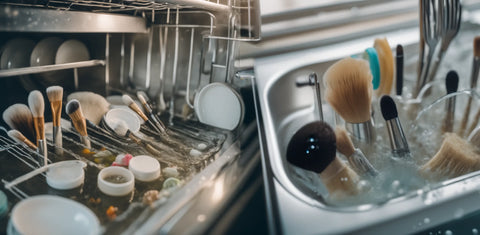Don't Underestimate the Importance of Keeping Your Brushes Clean and Well-Maintained!
Makeup brushes are essential tools for achieving that flawless look, but they can also harbour bacteria and dirt if not cleaned properly. Let's dive into why and how you should take the time to maintain your precious bristles.
Why Should You Clean Your Makeup Brushes?
Cleaning brushes is crucial for several reasons:
- Hygiene: Unclean brushes are a breeding ground for bacteria and can lead to skin issues like acne.
- Performance: Dirt and residue can compromise the effectiveness of your brushes. A clean brush ensures a smoother and more precise application.
- Longevity: Regular cleaning extends the lifespan of your brushes, saving you money in the long run.
How Often Should I Clean My Makeup Brushes?
Should You Clean Makeup Brushes Every Day?
It may sound excessive, but certain brushes need more frequent cleaning than others. For example, brushes used for liquid or cream-based products should be cleaned after each use to prevent bacterial growth.
Deep Cleaning vs Everyday Cleaning
A light everyday cleaning to remove superficial dirt can be done using a tissue or a makeup remover wipe. However, a deeper, more thorough cleaning should be done every week or two.
What Should You Use to Clean Your Makeup Brushes?
Choosing the right cleaning agents is essential. Below, check also what not to use!
- Baby Shampoo: Gentle yet effective. A popular choice for a reason.
- Antibacterial Soap: Kills bacteria effectively but can be harsh on the bristles if used too often.
- Hand Soap: Another mild option, suitable for regular cleaning.
- Vinegar: A natural alternative, but make sure to dilute it well.
- Micellar Water: Effective but may require a rinse with another agent to remove all residue.
- Dish Soap: Strong on greases but too harsh for regular use.
- Brush Cleaner: Specially formulated products available that disinfect and condition the brush fibres.
What Is the Best Homemade Way to Clean Makeup Brushes?
The Complete Cleaning Makeup Brushes Process in 10 Steps:
- Gather Supplies: Get all your cleaning agents and tools ready.
- Rinse: Rinse the bristles under lukewarm water.
- Soap Up: Use a small amount of your cleaning agent of choice.
- Lather: Rub the brush against your palm or a silicone brush mat.
- Rinse Again: Make sure all soap residue is gone.
- Condition: Optional, but it can help keep bristles soft.
- Rinse Final Time: Make sure all the conditioner is out.
- Remove Excess Water: Use a clean towel to remove excess water.
- Reshape: Use your fingers to reshape the bristles.
- Dry Properly: Air dry by hanging them upside down to keep water from loosening the glue in the handle.
10 Common Mistakes to Avoid When Cleaning Makeup Brushes revealed:

- Using the Dishwasher: Never put your brushes in the dishwasher. The intense heat and harsh detergents can ruin your bristles and loosen the glue holding the brush together.
- Excessive Soaking: While it may seem like a good idea to let the brushes soak to remove stubborn grime, doing so can loosen the glue that holds the bristles in place.
- Ignoring Regular Cleaning: If you think occasional cleaning will suffice, think again. The longer you wait between cleaning cycles, the more bacteria will accumulate.
- Wrong Cleaning Agents: Using overly harsh or abrasive cleaners can prematurely age your brushes. Stick to mild soaps or specific brush cleaners.
- Improper Storage: Once cleaned, brushes should be stored in a cool, dry place. Keeping them in a damp bathroom can invite mould and bacteria.
- Not Rinsing Enough: Residue from soap or cleaner can irritate your skin. Make sure to rinse your brushes thoroughly.
- Using Hot Water: Hot water can loosen the glue that holds the bristles and affect the shape of your brush. Always opt for lukewarm water.
- Skipping the Reshaping Step: After rinsing, it’s crucial to reshape the bristles while they are wet to maintain their original form.
- Fast Drying Tactics: Using a hair dryer to speed up the drying process may seem convenient, but the heat can damage the bristles. Air-drying is your best bet.
- Lack of Conditioning: Just like your hair, brush bristles can benefit from conditioning. However, this is often skipped, leading to bristles becoming dry and brittle over time.
How Professional Makeup Artists Clean Makeup Brushes?
In a professional setting, brushes are often cleaned after every single use to meet hygiene standards. Pro artists might also use faster-drying alcohol-based cleaners for quick turnarounds between clients.
When Should the Brush Be Replaced and Not Cleaned?
When bristles begin to fray, shed, or lose their shape, it may be time to say goodbye.
Protect Your Investment
Remember, proper brush cleaning isn't just about hygiene—it also prolongs the life of your brushes, ensures smooth makeup application, and promotes healthy skin. By following these simple steps, you can enjoy flawless makeup and maintain the health of your skin for years to come.







